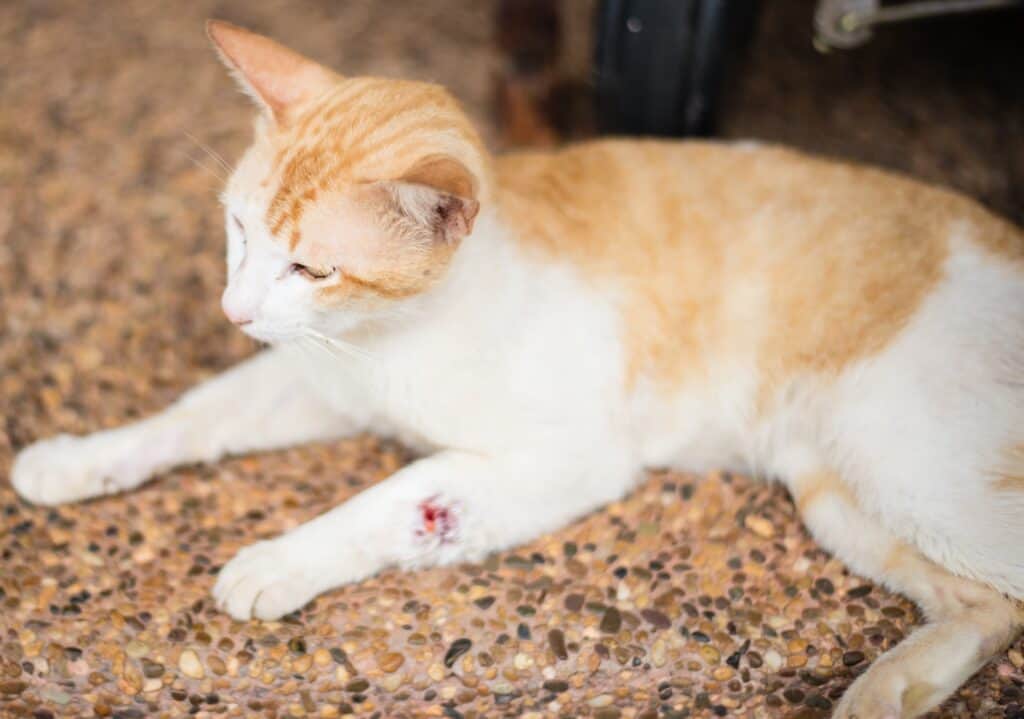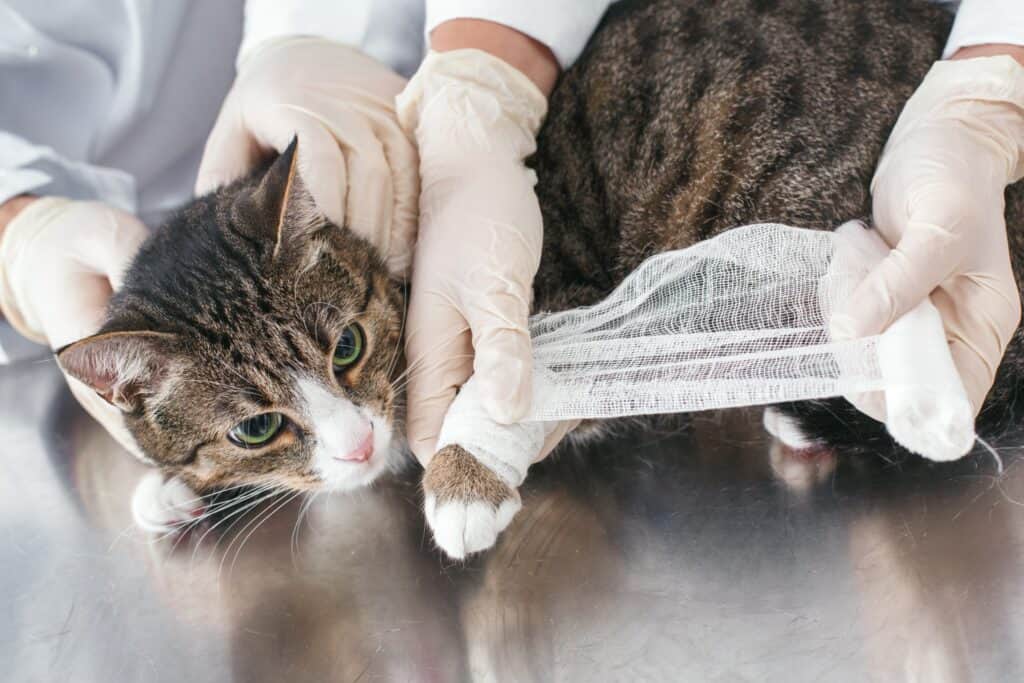If you are asking “why my cat is limping,” then undoubtedly you have a lot of worries and questions. Is it a sprain, a fracture, or a sign of a more serious health condition? Is my cat in pain?
As a cat owner, one of the most distressing sights can be to witness your normally agile and graceful pet struggling with a limp. But how do you know when not to worry and when you need to take your cat to the vet?
This article aims to guide you through the possible reasons behind your cat’s limp, the process of diagnosis, and potential treatment plans. It also emphasizes the importance of consulting with a veterinarian as soon as possible for an accurate diagnosis and effective treatment.
We’ll look at common worries, the duration of a limp, and ways to distinguish between a broken leg and a sprain in cats. By the end of this article, you’ll be better informed about what your cat’s limp could indicate and the next steps to take in caring for your feline fur baby.
Why Is My Cat Limping?
Limping, or lameness, in cats is usually seen as an abnormal gait or a reluctance to put weight on a particular limb.
The limping may be barely noticeable or extremely evident. In mild cases, a cat might just have a slight hitch in its step. In more severe cases, the cat may completely hold up the affected limb and refuse to put any weight on it at all.
Sometimes, limping may come and go, appearing more noticeable when the cat first gets up from resting and then seeming to improve as they move around.
You Might Not Notice A Slight Limp In Your Cat
Limping in cats is often very subtle, and cat owners may not notice at first because the cat is so good at hiding it. Cats are often stoic creatures who do not vocalize or show obvious signs of pain until it becomes unbearable.
This is because as solitary hunters by nature, cats instinctively hide their pain to avoid appearing vulnerable to predators. This instinct still exists in domestic cats, making it difficult for owners to recognize when their pets are in pain.
Cats are good at compensating for mild discomfort. A slight limp can be hard to detect, especially in cats with long fur that may hide limb movements. Other signs of pain, like reduced activity, hiding, not eating, or other changes in behavior can be easily missed if one isn’t actively looking for them.
In some cases, by the time a cat is noticeably limping, the pain or injury may have been present for some time.
Common Reasons Why Your Cat Is Limping
Cats may limp due to various reasons, such as minor injuries or strains, as well as more serious health issues like arthritis or fractures.
Some of the causes of limping include:
Injuries
- Sprains and Strains: Cats are active and agile creatures, but they can still sprain or strain their muscles and ligaments, especially if they fall or jump from high places.
- Fractures: Broken bones, though less common, can occur from accidents such as falls or impacts. Cats allowed to roam outdoors are at most risk of broken bones. You’ll usually see a noticeable limp or the cat not using the limb at all.
- Paw Injuries: Cuts, punctures, or abrasions on the paws can cause limping. This can be caused by stepping on sharp objects, hot surfaces, or from bites from fighting with other cats.

Joint Problems
- Arthritis: Arthritis is a common issue in older cats. It’s a degenerative joint disease that causes pain and stiffness, resulting in a noticeable limp that tends to be worse after resting and gets better when the cat starts moving.
- Hip Dysplasia: Some breeds, such as Maine Coons, are prone to hip dysplasia, a condition where the hip joint doesn’t form properly, leading to pain and limping.
Infections And Diseases
- Bacterial or Fungal Infections: Infections in the paw pads or between the toes can cause discomfort and limping. While this is much more common in dogs, it does occasionally occur in cats.
- Lyme Disease: Lyme disease, which is carried and transmitted by black-legged ticks, can cause intermittent lameness as well as other symptoms.
- Nail Disorders: Overgrown or ingrown nails or nail-bed infections can cause considerable pain and lead to limping.
Neurological Issues
- Spinal Problems: Spinal problems like intervertebral disc disease can affect a cat’s gait.
- Nerve Injury: Damage to nerves, perhaps from an injury, can result i pain or paralysis of a limb.
- Neuropathy: Disease or dysfunction of one or more peripheral nerves, such as polyneuropathy of Bengal cats, can cause cats to limp because of weakness in one or more limbs.
Cancer
- Bone Cancer: Though rare, bone cancer can cause significant pain and lameness in cats.
- Other Cancers: Some cancers can affect the nerves or the muscles of the limbs, which can also lead to limb weakness, paralysis, or pain.
Insect Bites Or Stings
- Allergic Reactions: Bites or stings can cause swelling and pain, leading to a limp.
Overexertion
- After Vigorous Play: Sometimes, after an intense play session or exercise, a cat might temporarily limp due to overexertion.
Blood Clots
- Aortic Thromboembolism: This is a severe condition where a blood clot lodges at the base of the aorta, often leading to sudden and severe limping or paralysis of the hind limbs. This is an extremely painful, life-threatening condition that more often affects cats with heart disease such as Hypertrophic cardiomyopathy (HCM).
What To Do If Your Cat Is Limping
If you see your cat is limping but is not showing signs of distress such unusual meowing, howling, or aggressive or defensive behavior like hissing, swatting, or biting, you can try to examine the limb for any visible injuries.
However, if your cat appears to be in a lot of pain or is clearly in distress, you should seek immediate veterinary care.
Maintain Composure And Gentle Handling
Make sure to remain calm when dealing with a limping cat. A calm attitude helps minimize the animal’s stress levels and makes it more approachable. Always use a “fear free” approach and do not force the cat to submit to being handled.
Gentle handling that doesn’t cause pain is necessary to avoid further injuries or scaring the cat.
Conducting A Careful Examination
Start by observing your cat’s movements and posture for anything out of the ordinary. This may help identify the limb or part of the limb that is causing the lameness. For example, a cat with a painful back leg may spend more time laying down, while a cat with a sore front leg may sit with the leg raised.
Then, if the cat will allow it, gently examine the cat, starting from non-painful areas and gradually moving towards the affected leg.
Softly press over each muscle, joint, and bone and observe the cat’s reactions closely during this examination to look for any sensitive areas. Any indication of pain or resistance should be a cue to cease the examination to prevent further injury or distress.
Continue with checking the cat’s paw for any cuts, swelling or foreign objects like splinters. Check the their nails closely to look for damaged or infected claws.
The solution to the limp may be as simply as trimming an overgrown or ingrown claw or removing a splinter. If you do find a small cut, scratch, or bite, gently clean the wound with warm water and a mild soap. Continue to monitor the injury for several days to make sure it is healing properly and there are no signs of infection.
A bites or puncture wound over a joint can turn septic very quickly, and should be seen by a vet as soon as possible.
Managing Mild Limping When There Is No Sign Of Injury
If a cat that has only a mild limp does not react painfully to palpation of the limb and you do not find any visible injuries, it may be best to simply give them some rest. Mild muscle strain will usually resolve on its own in a few days.
Keep the cat in a quiet and comfortable environment with low surfaces and kitty bed or their favorite blankets. Monitor their movements closely for a day or two. You may have to keep it separately from other cats in the household to prevent any rough play or running about.
If the limp appears to worsen or has not improved after two days, seed veterinary advice.
Do NOT Give Your Cat Pain Medications That Are Not Prescribed By A Vet!
We cannot emphasize this enough – NEVER give your cat over the counter pain medications like aspirin, ibuprofen or acetaminophen. These substances are toxic to cats and can result in the death of your cat.
Always consult your veterinarian for any pain management recommendations and follow their instructions closely. They may prescribe anti-inflammatory medications like meloxicam or steroids for short term use, along with rest and supportive care like warm compresses or massage if needed.

Should I Take My Cat To The Vet?
While mild limps can resolve on their own with rest, in many cases the proper approach is to have the cat examined for a proper diagnosis and treatment by a veterinarian.
In addition to providing treatment for injuries and infections that you may not have noticed, they can also detect underlying issues like arthritis or orthopedic problems that require proper treatment.
The following situations indicate the need for immediate veterinary attention include:
- Severe or Sudden Onset of Limping: If the limping arises suddenly and is severe, it suggests a significant injury or acute medical issue.
- Visible Wounds or Swelling: Open wounds, bleeding, or noticeable swelling around the limb or paw indicate a serious injury.
- Signs of Infection: Cats are prone to getting abscesses, especially from bite or scratch wounds. Redness, warmth, pus, or a foul smell from a wound or swollen area can indicate an infection.
- Non-Weight Bearing Limping: If the cat refuses to put any weight on the limb it could signify a fracture or severe sprain. A limb that is dangling or at a strange angle is more likely to be fractured.
- Persistent Limping: Limping that lasts more than 24-48 hours without improvement should be evaluated, as it could be a sign of a chronic issue like arthritis or a more serious underlying condition.
- Painful Reactions: If the cat shows signs of pain when touched or while moving, such as hissing, growling, or attempting to bite.
- Behavioral Changes: Changes in behavior, such as increased aggression, hiding, lack of appetite, or unusual lethargy.
- Other Symptoms: Accompanying symptoms like fever, vomiting, diarrhea, or difficulty breathing.
- History of Trauma: If you know or suspect the cat has had a recent fall, accident, or injury.
- Chronic Medical Conditions: Cats with pre-existing medical conditions, especially those that affect mobility (like arthritis), should be seen promptly if limping occurs.
In all these cases, a veterinarian can properly diagnose the issue and provide appropriate treatment, minimizing the risk of complications and ensuring the best possible outcome for the cat’s health.
Importance Of Professional Diagnosis And Treatment
Veterinarians are experienced and trained to diagnose and treat various medical conditions in animals. Attempting to self-diagnose or treat your cat can lead to serious consequences, including making the condition worse or causing additional injuries.
At the veterinary clinic, your vet will make sure your cat gets a thorough physical examination, reviews the cat’s medical history, and potentially runs diagnostic tests. These tests, like X-rays, blood tests, and ultrasounds, are important for identifying the problem.
Once the veterinarian has an accurate diagnosis of your pet’s condition, they can determine the best treatment. This might involve prescribing medications, recommending surgery, suggesting dietary changes, or starting physical therapy, depending on the cat’s specific needs.
They can also prescribe proper pain medications that are safe for your cat. Just like you can benefit from pain relievers, your cat will feel better with proper pain relief as well.
Acting early and accurately is critical as it not only addresses the immediate issue but also prevents potential complications. By catching and treating problems early, there’s a better chance of preventing further injuries or illnesses, leading to a quicker and more complete recovery for the cat.
In addition, some underlying causes of limping may not be obvious without proper diagnostics, such as X-rays or blood work. Only a veterinarian can provide these services and determine the most suitable treatment plan
What To Expect During A Veterinary Appointment
Reception and History Taking: During your pet’s first appointment, the vet will gather information about your cat’s symptoms, medical history, and any recent incidents that could have led to the current condition.
Physical Examination: The vet will examine your cat, focusing on the area of concern but also assessing overall health. They may palpate (feel) areas to check for pain, swelling, or abnormalities.
Diagnostic Testing: If necessary, the vet might recommend diagnostic tests. These can range from simple in-office procedures like a blood test to more complex imaging like X-rays or MRIs, depending on the symptoms.
Discussion of Findings: After the examination and any tests, the vet will discuss their findings with you. They will explain the diagnosis, possible causes, and treatment options.
Treatment Plan: The vet will propose a treatment plan, which may include medications (including pain medication that is safe for cats), recommendations for rest or activity modification, dietary changes, or further procedures like surgery.
Follow-up Care: Instructions for at-home care will be provided. This may include how to administer medications, wound care, or monitoring for any changes in symptoms. Additionally, follow-up appointments may be scheduled to assess progress.
How Long Does A Cat Limp Last?
The duration of a cat’s limp can vary greatly depending on the underlying cause. In some cases, a limp may resolve within a few days, especially if it’s due to a minor strain or sprain.
For instance, if a cat has simply landed awkwardly after a jump, the limping might cease as the minor injury heals with rest.
However, if the limp is caused by more serious issues like fractures, severe sprains, infections, arthritis, or other medical conditions, the duration can be significantly longer. In such cases, recovery time depends on the severity of the condition and the effectiveness of the treatment.
For example, fractures may require weeks to months of healing, depending on their severity and the treatment approach (such as surgery or immobilization).
Chronic conditions like arthritis might cause intermittent limping that can persist or recur over the cat’s lifetime. These cases often require ongoing management rather than a definitive cure.

How Do You Tell If Your Cat’s Leg Is Broken Or Sprained?
When a cat owner sees their cat limping, their mind often jumps to the worst case scenario – is my cat’s leg broken? How can I tell?
Differentiating between a broken leg and a sprain in a cat can be challenging without professional veterinary expertise, as both conditions can present similar symptoms. However, there are some signs you can look for to make an initial assessment:
- Severity of Limping or Non-Use of Limb: A cat with a broken leg will likely not use the affected limb at all and may hold it up or at an odd angle. A sprain might also cause limping, but the cat may still use the limb gingerly.
- Signs of Swelling and Bruising: Both fractures and sprains can cause swelling, but a break might also show significant bruising and may have a more pronounced swelling, both of which can be difficult to see through the cat’s fur.
- Pain Response: A broken leg is typically very painful. If your cat reacts strongly to gentle palpation or movement of the area (considering this should be done very carefully to avoid causing more pain), it might indicate a break. A sprain will also be painful but might not elicit as severe a reaction.
- Visible Deformity: In the case of a severe break, you might notice that the limb is in an odd position – the leg may appear bent or twisted in an unnatural way. This is less likely with a sprain.
- Behavioral Changes: Both injuries can cause a cat to exhibit behavioral changes due to pain, such as hiding, decreased activity, loss of appetite, or aggression.
- History of Trauma: Knowing the history – such as a fall from a height or a noticeable accident – can give clues. A significant trauma is more likely to result in a fracture.
Only a trained veterinarian can accurately diagnose a broken leg or a sprain. Both conditions require professional medical attention. A fracture, especially, can have serious consequences if not properly treated. In extreme cases, a broken bone that does not receive prompt care may need to be amputated.
Even if you suspect it’s “just” a sprain, a vet visit is warranted to ensure appropriate care and to rule out more serious injuries. If your cat is showing any of these signs, it’s best to consult a veterinarian as soon as possible.
Conclusion
Cats can limp due to various reasons, such as minor injuries, sprains, arthritis, infections, neurological issues, and even cancer.
It’s important for pet parents to stay vigilant and observant, because cats are good at hiding their pain. Even a slight limp should not be ignored as it could indicate a serious underlying problem.
While mild limps may improve with rest, it’s safer to consult a veterinarian, especially if you notice severe or persistent limping, visible wounds, signs of infection, or behavioral changes. Acting promptly can lead to faster recoveries and prevent complications.
When unsure, seek veterinary care. Your cat relies on you as their advocate and caretaker, so don’t hesitate to seek professional guidance and support.
Disclaimer: This article is intended for informational purposes only, and does not constitute medical advice. Always consult your veterinarian if you have specific concerns about your pet’s health.

